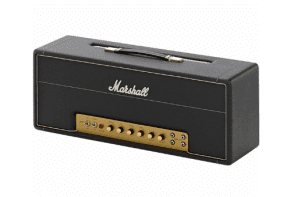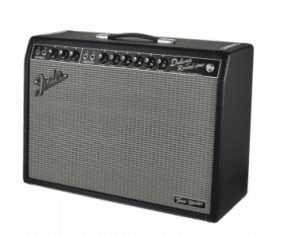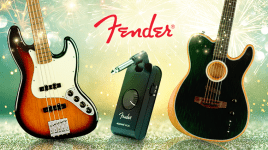
When it comes to the tone, guitarists often come out as quite conservative contemporaries. Since the 1950s, an aesthetic sound ideal has been established in the field of amplifiers, which despite all its facets and nuances can be described as a standard. While the technical features have evolved over the decades, from all-tube to transistor to modeling and hybrid amplifiers, the preferred sounds have remained similar, almost identical. Below, we’ll talk about some of the iconic amp brands that have defined the sound of the decades.
Marshall
With his amps, Jim Marshall probably put the most obvious stamp on the sound of rock ‘n’ roll. Over the decades he has brought various models onto the market and thus onto the stages of the world. Whether it’s alongside Jimi Hendrix or many other guitar heroes, the “1959” amp was and is constantly found as a companion – it’s arguably the Marshall amp with the most eventful history, with the most reissues and special series, that has ever existed in the history of the Brits. And since 2004, there has been (parallel to the 1959SLP from the New Vintage series) yet another edition. The 1959HW is a very special treat, because it is completely hand-wired using the exact same manufacturing techniques for producing Jimi Hendrix’s stage amps (at that time still in Jim Marshall’s first factory in Hayes).

Marshall 1959 HW
Fender
Fender has established itself from the start as the complete opposite of the Brit sound and is one of the classic amp manufacturers par excellence. Fender’s amps were formative for the Californian amp sound. Since then they have proven their qualities in almost every genre. In fact, Fender has countless models such as the Tweed amps, the Twin Reverb, Bassman or the Fender Deluxe Reverb, which many perceive as the typical Fender clean tone. While huge racks with power amps and preamps as well as expensive studio effects were popular in the ’80s, the trend is currently going back to combos or heads with 4×12” boxes. The Deluxe Reverb is currently appearing as the little brother of the Twin Reverb. The advantage of the Deluxe lies in the much lower output, which means that it can be driven into harmonic distortion even at moderate volumes. The Deluxe also delivers excellent clean sounds, the Fender-typical spring reverb and the tube vibrato effect for more vintage sound variants.
Vox
Along with Marshall and Fender, Vox amps are among the true guitar amp classics. In fact, the AC30 and AC15 in particular with treble boosters, multi-delays and reverbs have shaped the tonal appearance of beat, rock and co. since the 1960s. Not least because of the Beatles, the Vox amps came into global focus. A number of other guitarists have entrusted their sound to Made in Britain combo amps in the years since. Queen guitarist Brian May is one of the flagship heroes who were and are inextricably linked to the Vox AC30. Known for his unmistakably singing sound, he usually stacked 9 Vox AC30s in three rows on top of each other. With the Vox AC30 C2X Blue Bulldog the all-tube combo has been relaunched as a gently modernized cult amp with typical features. Equipped with 3x 12AX7 (ECC83) preamp tubes and 4x EL84 power amp tubes, the amp delivers a whopping 30 watts of power. They sound through the two Blue Bulldog Alnico loudspeakers, which are known for their excellent quality.
Mesa Boogie
From the 1970s, Mesa Boogie became the studio standard for many guitarists such as Carlos Santana, Al Di Meola, Steve Lukather and John Petrucci. The amps of James Hetfield, Kirk Hammett, Robert Trujillo or Cliff Burton were also part of the Mesa Boogie gang. In the high-gain sector, the company first gained a large following with the Mark IV and then with the Rectifier. Unfortunately, after being acquired by Gibson a few years ago, the Mesa Boogie flew off the shelves of many retailers. Nevertheless, the scene hopes that the high-gain signs will change again and that Mesa Boogie will soon be able to build high-quality amplifiers without sacrificing quality.
Soldano
The ideal sound from the end of the ’80s called for higher distortion values and gain structures. If you wanted to deliver more modern sounds with more gain as a guitarist, you could hardly avoid modifications to the amplifier. Mike Soldano was no longer an insider tip among insiders when it came to modifying amplifiers. The Soldano SLO100 was born in 1987 and has been produced, by hand, for months since then. Soldano managed to become a classic in the amplifier world as a late innovator. The legendary high-gain amp head always had to struggle with a fair amount of noise. The reissue version from 2020 is the precious Soldano SLO-100 amp head modified on this point in particular and scores with a significantly lower noise level. Hum and crosstalk between the channels are prevented by improved grounding and revised power supply electronics. You can find all Soldano amps at thomann.de here!
More amps on the market
Of course, there are numerous other amplifiers, each with their own qualities and special advantages. This starts with Hiwatt , Orange , Laney and Music Man , extends to Peavey or Engl and ends with boutique models from e.g. B. Diezel , Bogner , Dumble or Friedman by a long shot. To illuminate all of them here would certainly have its appeal, would certainly go beyond the scope and your patience. But the video below is all the more interesting, in which our guitar specialists crank up four of the popular reissues and put them to the test.
Legendary Amplifiers | Video
In our video below, Kris and Guillaume check out the Legends’ amp tone. Caution: LOUD!
You are currently viewing a placeholder content from YouTube. To access the actual content, click the button below. Please note that doing so will share data with third-party providers.
Quiz time
Did you learn something after reading this article? Find out by taking our quiz!
You can currently see the contents of the Riddle Technologies AG placeholder. You can access the actual content by clicking the button below. Please note that the information is transmitted to third party service providers.
What do you think of these amp legends? Let us know what you think in a comment!
You are currently viewing a placeholder content from Facebook. To access the actual content, click the button below. Please note that doing so will share data with third-party providers.
More InformationYou are currently viewing a placeholder content from Instagram. To access the actual content, click the button below. Please note that doing so will share data with third-party providers.
More InformationYou are currently viewing a placeholder content from X. To access the actual content, click the button below. Please note that doing so will share data with third-party providers.
More Information







